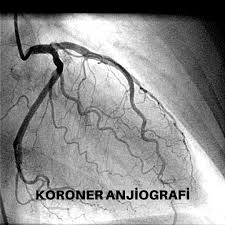It is a method used to detect disease of the arteries supplying the heart. It is used in the diagnosis of cardiovascular diseases. Coronary angiography determines which part of the arteries supplying the heart is narrowed or blocked and to what extent. By identifying stenosis or blockages in the heart vessels, it ensures that the treatment is directed as needed. In coronary angiography, the groin or arm arteries are used as the site of intervention. First, a sheath is inserted into the artery at the site of intervention, and through this sheath, using different catheters, the vascular structure is visualized with an opaque substance (dyed substance) given to the beginning of the heart vessels. Coronary angiography is performed in specially equipped angiography rooms. After the procedure, the sheath placed on the artery at the site of the intervention is removed and pressure is applied to the area to stop bleeding. After a tight bandage is applied, the patient is taken to bed. Coronary angiography is completed 20 to 30 minutes after the patient is admitted to the angiography room. In some cases (bypass patients, patients who have undergone various heart surgeries, patients with blockages in the groin or arm veins, etc.) this time may be longer. Hospitalization is required for coronary angiography. After the procedure is completed, the patient is allowed to rest for 6 hours and then allowed to stand up. If the general condition is favorable and the doctor approves, the patient is discharged. In some cases, a suture system can be used after the sheath is removed. These patients can be discharged by standing up earlier.
= =Page content is for informational purposes only. Please consult your doctor for diagnosis and treatment.









